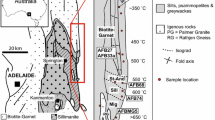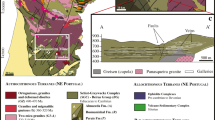Abstract
To interpret correctly the isotopic composition of metmorphic rocks and minerals, the effect of nettransfer reactions must be quantitatively evaluated. Such evaluation requires a complete set of linearly independent, net-transfer reactions that fully describe the reacting system. The set of net-transfer reactions is then coupled with mass-balance equations for stable isotopes. Reaction spaces can be contoured with isopleths of °18O, °13C, and δD of minerals which allows evaluation of the effect of different reactions and bulk compositions on the stable isotopic composition of minerals and rocks. Using this approach, we examined the effect of fractionation of isotopes due to net-transfer reactions at the biotite and second-sillimanite isograds in northern New England. Our analysis shows that the shift in °13C and °18O at an isograd depends strongly upon the overall net-transfer reaction at the isograd and the bulk composition of the rock. The use of model isograd reactions to determine isotopic shifts, therefore, can lead to serious errors in the interpretation of isotopic data. At the second-sillimanite isograd °18O qtz (quartz), °18O kspar (K feldsdpar), and °18O wr (whole rock) decrease by ∼0.5, 1.0, and 0.8 per mil, respectively. Quantitative evaluation of the effect of fractionation of isotopes by net-transfer reactions shows that: (1) the relative changes in oxygen isotopes across the isograd could be caused by distillation of fluids during develatilization reactions; (2) the magnitude of the observed isotopic shifts often differs by a factor of 2 from the calculated shifts due to reaction progress alone. The difference between observed and calculated shifts is attributed to either, differences in bulk composition between individual rocks, or, to isotopic exchange between minerals after peak metamorphism. At the biotite isograd the shifts in carbon and oxygen isotope values are different from predicted shifts caused by net-transfer reactions alone. This discrepancy suggests that fluids infiltrated the rocks during the formation of the biotite isograd.
Similar content being viewed by others
References
Bence AE, Albee AL (1968) Empirical correction factors of the electron microanalysis of silicates and oxides. J Geol 76:382–403
Bottinga Y, Javoy M (1973) Comments on oxygen isotope geochemistry. Earth Planet Sci Lett 20:251–265
Carothers WW, Adami LL, Rosenbauer RJ (1988) Experimental oxygen isotope fractionation between siderite-water and phosphoric acid liberated CO2-siderite. Geochim Cosmochim Acta 52:2445–2450
Chamberlain CP (1986) Evidence for the repeated folding of isotherms during regional metamorphism. J Petrol 27:63–89
Chamberlain CP, Lyons JB (1983) Pressure, temperature, and metamorphic zonation studies of pelitic schists in the Merrimack synclinorium, south-central New Hampshire. Am Mineral 68:530–540
Chamberlain CP, Rumble D III (1988) Thermal anomalies in a regional metamorphic, terrain: an isotopic study of the role of fluids. J Petrol 29:1215–1232
Chamberlain CP, Rumble D III (1989) The influence of fluids on the thermal history of a metamorphic terrain: New Hampshire, USA. In: Daly JS, Cliff RA, Yardley BWD (eds) Evolution of metamorphic belts. Geol Soc Spec Publ 42:203–213
Clayton RN, Mayeda TK (1963) The use of bromine penta-fluoride in the extraction of oxygen from oxides and silicates for isotope analysis. Geochim Cosmochim Acta 27:43–52
Englund EJ (1976) The bedrock geology of the Holderness quadrangle, New Hampshire. NH Dep Resour Econ Dev Bull 7:1–85
Ferry JM (1983) Application of the reaction progress variable in metamorphic petrology. J Petrol 24:343–376
Ferry JM (1984) A biotite isograd in south-central Maine, USA: mineral reactions, fluid transfer, and heat transfer. J Petrol 25:871–893
Ferry JM (1986) Infiltration of aqueous fluid and high fluid: rock ratios during greenschist facies metamorphism: a reply. J. Petrol 27, 695–714
Ferry JM (1988a) Contrasting, mechanisms of fluid flow through adjacent stratigraphic units during regional metamorphism, south-central Maine, USA. Contrib Mineral Petrol 98:1–12
Ferry JM (1988b) Infiltration driven metamorphism in northern New England, USA. J Petrol 29:1121–1159
Ferry JM, Spear FS (1978) Experimental calibration of the partitioning of Fe and Mg between garnet and biotite. Contrib Mineral Petrol 66:113–117
Friedman I, O'Neil JR (1977) Compilation of stable isotope fractionation factors of geochemical interest. US Geol Surv Prof Pap 440-K
Gregory RT, Criss RE (1986) Isotopic exchange, in open and closed systems. In: Valley JW, Taylor HP, O'Neil JR (eds) Stable isotopes in High Temperature Geological Processes. Mineral Soc Am, Reviews in Mineralogy 16, pp 91–140
Helgeson HC, Delany JM, Nesbitt HW, Bird DK (1978) Summary and critique of the thermodynamic properties of rock-forming minerals. Am J Sci 278-A:1–229
Garlick GD, Epstein S (1966) Oxygen isotope ratios in coexisting minerals of regionally metamorphosed rocks. Geochim Cosmochim Acta 31:181–214
Lyons JB, Bothner WA, Moench RH, Thompson JB Jr (1984) Interim bedrock geologic map of New Hampshire. Office of the State Geologist. Durham, NH
Matsuhisa Y, Goldsmith JR, Clayton RN (1979) Oxygen isotopic fractionation in the system quartz-albite-anorthite-water. Geochim Cosmochim Acta 43:1131–1140
McCrea JM (1950) On the isotopic chemistry of carbonates and a paleotemperature scalc. J Chem Physics 18:849–857
O'Neil JR, Taylor HP (1967) Oxygen isotope equilibration between muscovite and water. J Geophys Res 74:6012–6022
Robie RA, Hemingway BS, Fisher JR (1978) Thermodynamic properties of minerals and related substances at 298.15 K and 1 bar (105 pascals) and at higher temperatures. US Geol Surv, 1452
Rosenbaum J, Sheppard SMF (1986) An isotopic study of siderites, dolomites, and ankerites at, high temperatures. Geochim Cosmochim Acta 29:1147–1150
Rumble D III (1982) Stable isotopic fractionation during metamorphic devolatilization reactions. In: Ferry JM (ed) Characterization of metamorphism through mineral equilibria. Mineral Soc Am, Reviews in Mineralogy 10, pp 327–352
Rumble D III, Ferry JM, Hoering TC, Boucot AS (1982) Fluid flow during metamorphism of the Beaver Brook fossil locality, New Hamsphire. Am J Sci 282:886–919
Russ-Nabelek, C (1989) Isochemical metamorphism of mafic schist, Laramie Anorthosite Complex, Wyoming: amphibole compositions and reactions. Am Mineral 74:530–548
Thompson JB Jr (1982a) Reaction space: an algebraic and geometric approach. In: Ferry JM (ed) Characterization of metamorphism through mineral equilibria. Mineral Soc Am, Reviews in Mineralogy 10, pp 33–51
Thompson JB Jr (1982b) Composition space: an algebraic and geometrical approach. In: Ferry JM (ed) Characterization of metamorphism through mineral equilibria. Mineral Soc Am, Reviews in Mineralogy 10, pp 1–32
Thompson JB, Laird J, Thompson AB (1982) Reactions in amphibolite, green schist and blue schist. J Petrol 23:1–17
Tracy RJ, Rye DM; Hewitt DA, Schiffries CM (1983) Petrologic and stable-isotopic studies of fluid-rock interactions, south-central Connecticut: I. The role of infiltration in producing reaction assemblages in impure marbles. Am J Sci 283-A:589–616
Valley JW (1986) Stable isotope geochemistry of metamorphic rocks. In: Valey JW, Taylor HP, O'Niel JR (eds) Stable isotopes in high temperature geological processes. Mineral Soc Am, Reviews in Mineralogy 16, pp 445–486
Wenner DB, Taylor HP Jr (1971) Temperatures of serpentization of ultramafic rocks based upon 18 O/16 O fractionation between coexisting serpentine and magnetite. Contrib Mineral Petrol 32:165–185
Wood BJ, Graham CM (1986) Infiltration of aqueous fluid and high fluid: rock ratios during greenschist facies metamorphism: A discussion. J Petrol 27:751–761
Author information
Authors and Affiliations
Rights and permissions
About this article
Cite this article
Chamberlain, C.P., Ferry, J.M. & Rumble, D. The effect of net-transfer reactions on the isotopic composition of minerals. Contr. Mineral. and Petrol. 105, 322–336 (1990). https://doi.org/10.1007/BF00306542
Received:
Accepted:
Issue Date:
DOI: https://doi.org/10.1007/BF00306542




